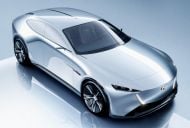Thought bubble. The Australian new-car market is already a crowded one, with around 50 brands competing hammer-and-tongs over a little more than a million sales each year.
This is compounded by the fact that one brand, market-dominator Toyota, has more than one-fifth of the total market all to itself. Year, on year, on year.
Yet this state of affairs is in no way stopping an army of largely unfamiliar brands looking to these fertile shores as a new sales opportunity – as the links at the bottom of the page show.
Australia, a rich nation in the Asia-Pacific region with a populace crowded into a few urban centres and a small-enough scale to not require some monstrous investment to enter, has long been seen as a perfect place for aggressive OEMs to expand into.
In the recent past we have seen the beginning of a Chinese wave led by MG, and Great Wall Motor with its GWM and Haval nameplates.
We’ve also seen the explosion of Tesla into a bonafide volume player, Genesis come into its own as a standalone luxury marque, and Polestar enter the fray as a purveyor of EVs.
At the other part of the spectrum there’s the recent proliferation of American pickup trucks from the Ram and Chevrolet brands, neither of which used to sell here.
In no way is this trend slowing down either. To the contrary.
New entrants coming in 2022 include China’s BYD, a growing power in the EV space, as well as Cupra, itself a brand spun-off from Volkswagen’s SEAT division.
Then there’s dedicated 4×4 startup Ineos, with its Grenadier (an old school Land Rover Defender look-alike) on track to hit the country this year as well.
And how about Chery, yet another Chinese brand that sold some cheap and nasty products here last decade but which is now gearing up for an Australian return in the short-term future?
Or Geely’s Lynk & Co brand, maker of Volvo-based cars sold on subscription plans, which plans to be here before 2025?
And let’s not forget two new GWM sub-brands from China, called Ora (electric cars ) and Tank (4x4s), both of which are on track for debuts in 2022 or 2023.
Beyond this, the Australian importer for Renault wants the budget-friendly Dacia brand here too, admittedly at an unspecified point in time.
A few observations come to mind, looking at this growing list of myriad prospective new players – most of which look set to be on sale by 2023.
Firstly, some of these new entrants have or will eschew using traditional franchise dealers and instead use a so-called agency model, or a direct-to-consumer model pairing brand stores and e-commerce.
This tells you something about what OEMs really want, when a blank sheet of paper presents itself. They clearly don’t want you haggling or going to multiple dealerships.
But of equal importance, it’s also quite clear to me that Australia really cannot ideally support so many brands, many of which will be left to fight over table scraps.
If you’re a luxury marque with high margins, then perhaps you’ll be fine. But this army of new and growing competitors for the most part will be stealing customers from others.
How many of these familiar players can truly stand to lose customers and market share? Because some simply have to.
Existing, familiar brands that fail to set their products, prices or services apart from the pack will increasingly run out of opportunities, and I suspect some Australian-market operations will shrivel up or die as a result.
Especially when you consider in these times of stock shortages and supply chain snags, we’re seeing brands hiking their prices and making customers wait months on end to take delivery – either through a franchise network or one run in-house.
Not to mention some dubious behaviour from certain car dealers charging way over the odds for demos or hiking up their delivery fees, which reflects poorly on OEMs.
In short this is not a time for any smart car brand to lean on buyer loyalty as a guarantor of success.
A word to the car company managers in Australia: fail to play your cards right, fail to keep up with the times, and this perfect storm will bring about your decline and demise. The more brands join the party, the more alternatives your customer base will look to.
Consumers will be the winners. But who will be the losers? Because rest assured, some will be…
Tell us your thoughts below – do you think some of Australia’s better-known car brands are in strife?
MORE: BYD ‘overwhelmed’ by demand, plans 2022 Australia EV expansion
MORE: Chinese brand Chery on track for Australian relaunch in 2022
MORE: 2022 Cupra range, full Australian pricing revealed
MORE: Why Renault Australia wants to bring Dacia Down Under
MORE: 2022 Ineos Grenadier – Australia top-three in the world for reservations
MORE: Lynk & Co: Volvo’s Chinese sibling here by 2025
MORE: Ora electric car arrives in Australia from 2022
MORE: Tank-branded hybrid 4×4 SUV in Australia from 2022












